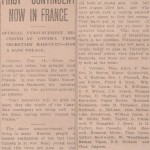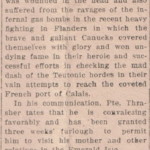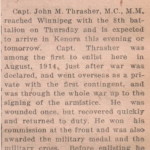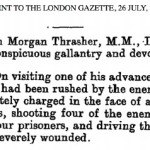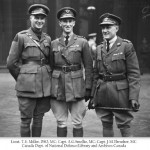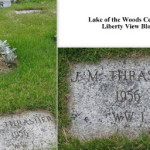

| Personal Details | |
| Date of Birth | December 27, 1887 |
| Place of Birth | Stafford, Ontario |
| Country | Canada |
| Marital Status | Single |
| Next of Kin | Mother: Jessie Thrasher, Beechburg, Ontario |
| Trade / Calling | Locomotive Lineman |
| Religion | Wesleyan |
| Service Details | |
| Regimental Number | 302 |
| Service Record | Link to Service Record |
| Battalion | 8th Battalion |
| Force | Canadian Expeditionary Force |
| Branch | Canadian Infantry |
| Enlisted / Conscripted | Enlisted |
| Address at Enlistment | Kenora, Ontario |
| Date of Enlistment | September 23, 1914 |
| Age at Enlistment | 26 |
| Theatre of Service | Europe |
| Prisoner of War | No |
| Survived War | Yes |
| Decorations and Medals | Military Cross, Military Medal |
| Death Details | |
| Date of Death | 19561020 |
| Age at Death | 69 |
| Buried At | Lake of the Woods Cemetery, Kenora, Ontario |
| Plot | Liberty View Block, 38E-36-1 |
Thrasher, John Mangan
John Mangan Thrasher was a man who lived in rare company. One of the first to volunteer for service in the Kenora area he served the entire war from the fall of 1914 to the spring of 1919 overseas. He rose through the ranks from Private to Captain, and was one of fewer than 100 men in the Canadian Expeditionary Force to be awarded both a Military Medal (for enlisted men) and a Military Cross (for junior officers) for gallantry.
Wounded three times, he returned to active duty each time to continue serving with his original unit, the 8th Battalion (Winnipeg Rifles). Due to casualties, promotions, and other transfers, researchers estimate as few as 40 of the over 1,200 men who were on the battalion’s initial nominal roll in October 1914 when it was formed were with the battalion when it returned to Canada in May of 1919.
Thrasher, the son of Philemon Thrasher and Jessie Searson of Stafford in Renfrew County, Ontario was working as a locomotive engineer for the CPR in Kenora when war was declared by Britain on August 4, 1914.
The mobilization of troops began immediately and the local militia unit in Kenora, the 98th Regiment, was directed to raise a group of 40 men and one officer from its own ranks and volunteers from the district as part of recruitment for Military District 10 (Manitoba and Northwestern Ontario) for Canada’s 1st Contingent being assembled at Valcartier, Quebec.
Local recruitment alone exceeded those numbers with 44 men coming from the Kenora/Keewatin area. Thrasher was one of the 44 to board a train east on August 23, 1914 bound for Valcartier.
Once there, the men, who’d already taken an oath of allegiance and been enlisted with their local militia units, signed attestation forms volunteering for overseas duty for the duration of the war.
Thrasher, like most of Kenora’s first group of volunteers, was assigned to the Winnipeg-based 8th Battalion of Infantry (Winnipeg Rifles). With barely two months training, the troops shipped to England on October 3 and after further training in England were in France and the war by February 1915.
Thrasher’s first injury occurred shortly after. A letter home from John Henderson, another Kenora man in the 8th Battalion, reported Thrasher had suffered a shrapnel wound to the head during fighting in March and April in the battle of Ypres. He was one of several men from the 1st contingent to be wounded that spring, and two others were killed in action.
In July, Thrasher wrote home himself while recovering in an English hospital. He noted that after his shrapnel wound, he had also been gassed. The combination of the two injuries kept him out of the front lines until September of 1915.
By 1916 he had been promoted to Lance Corporal and on July 22, 1916 he was awarded the Military Medal;
‘For conspicuous gallantry in action during the night of 13th/14th June 1916. When the battalion was moving up to relieve the units which had made the attack and regained our former positions about eighteen hours previously in the vicinity of Mount Sorrel. The battalion bombing platoon came under very heavy shell fire in Square Wood, suffered a number of casualties and became seriously split up. This N.C.O. with the greatest disregard of personal danger set about collecting his men and led all those who remained unwounded through heavy shell fire into the position they were to occupy. On arrival there was no one to give any information on the situation in that locality. He at once reconnoitred on the whole position and placed his men to the very best advantage. He then returned to Square Wood and assisted his Officer in collecting the remaining men and attending to the wounded, which when done he again led the party through heavy shell fire into their position. Throughout he displayed qualities of leadership and good judgement with excellent results’.
In July he was also wounded a second time, receiving shrapnel wounds to the right knee and buttock which required another return to England for hospitalization and treatment. Returning to active duty in October 1916 he was selected for officer training and appointed a temporary Lieutenant in January 1917. He took part in the major battles of that year including Vimy Ridge and Passchendaele, In January 1918 he received a further promotion to Captain.
The action near Fampoux in April 1918 resulted in shrapnel wounds to his right arm, both legs and an eye from an exploding enemy grenade.
On May 3, 1918 he earned a Military Cross and suffered his third wound. The medal card citation read: ‘For conspicuous gallantry and devotion to duty. On visiting one of his advanced posts found it had been rushed by the enemy. He immediately charged in the face of a shower of bombs, shooting four of the enemy, capturing four prisoners, and driving them out. He was severely wounded’.
Discharged in May from hospital and returned to the front, further surgery to repair scaring and remove the shrapnel fragment from his eye kept Thrasher out of action for all but two months of the rest of the war with most of his time spent in England training troops arriving from Canada.
Thrasher came home to Canada with the 8th Battalion in May of 1919.
Following the war Thrasher returned to his work with the CPR in Kenora. He married a local girl, Nellie Mills in 1922. The couple had three children: Nellie (married Fred Johnson), Stella (married Fred Hull) and Peter (Sachiko). In the late 1930’s Nellie left John and moved to Winnipeg with the children. A 1937 newspaper article reported that Thrasher and several other of his comrades from the war were involved in gold claim staking in the Rowan Lake area southeast of Kenora. He retired from the CPR as an engineer in 1950.
Predeceased by his wife Nellie in 1945 John passed away in Kenora on October 20, 1956.
John Mangan Thrasher, MM MC, is interred in the soldier’s section of the Lake of the Woods Cemetery. His small, flat grave stone, similar to that of other veterans of the era in the soldier’s section, reads simply J.M. Thrasher, 1956, WW1 and is further marked by a simple white cross bearing his name. John is commemorated on the Honour Roll of the Canadian Pacific Railway.
by Bob Stewart
Postscript: John’s gravemarker was replaced in 2015.

